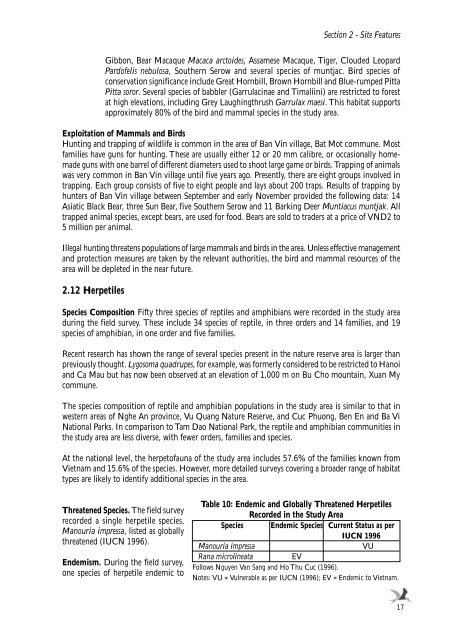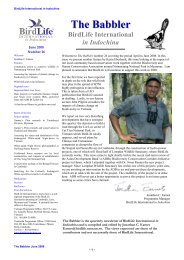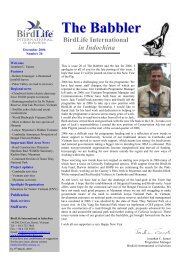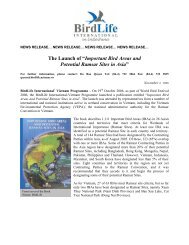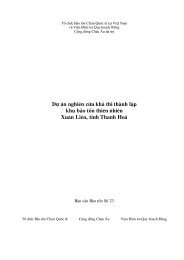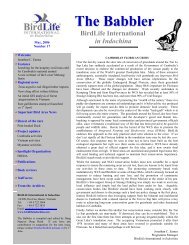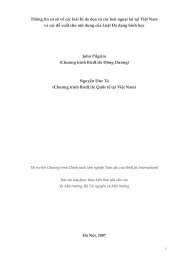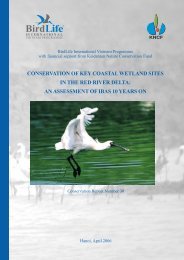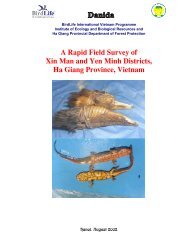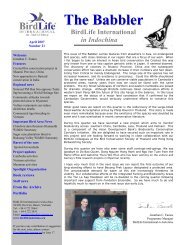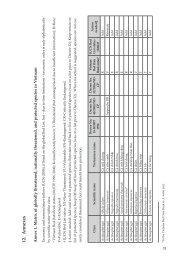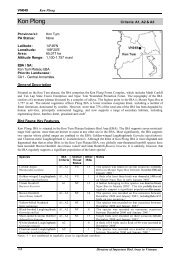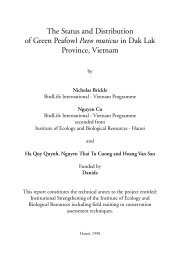A Feasibility Study for the Establishment of Xuan Lien Nature ...
A Feasibility Study for the Establishment of Xuan Lien Nature ...
A Feasibility Study for the Establishment of Xuan Lien Nature ...
Create successful ePaper yourself
Turn your PDF publications into a flip-book with our unique Google optimized e-Paper software.
Section 2 - Site Features<br />
Gibbon, Bear Macaque Macaca arctoides, Assamese Macaque, Tiger, Clouded Leopard<br />
Pard<strong>of</strong>elis nebulosa, Sou<strong>the</strong>rn Serow and several species <strong>of</strong> muntjac. Bird species <strong>of</strong><br />
conservation significance include Great Hornbill, Brown Hornbill and Blue-rumped Pitta<br />
Pitta soror. Several species <strong>of</strong> babbler (Garrulacinae and Timaliini) are restricted to <strong>for</strong>est<br />
at high elevations, including Grey Laughingthrush Garrulax maesi. This habitat supports<br />
approximately 80% <strong>of</strong> <strong>the</strong> bird and mammal species in <strong>the</strong> study area.<br />
Exploitation <strong>of</strong> Mammals and Birds<br />
Hunting and trapping <strong>of</strong> wildlife is common in <strong>the</strong> area <strong>of</strong> Ban Vin village, Bat Mot commune. Most<br />
families have guns <strong>for</strong> hunting. These are usually ei<strong>the</strong>r 12 or 20 mm calibre, or occasionally homemade<br />
guns with one barrel <strong>of</strong> different diameters used to shoot large game or birds. Trapping <strong>of</strong> animals<br />
was very common in Ban Vin village until five years ago. Presently, <strong>the</strong>re are eight groups involved in<br />
trapping. Each group consists <strong>of</strong> five to eight people and lays about 200 traps. Results <strong>of</strong> trapping by<br />
hunters <strong>of</strong> Ban Vin village between September and early November provided <strong>the</strong> following data: 14<br />
Asiatic Black Bear, three Sun Bear, five Sou<strong>the</strong>rn Serow and 11 Barking Deer Muntiacus muntjak. All<br />
trapped animal species, except bears, are used <strong>for</strong> food. Bears are sold to traders at a price <strong>of</strong> VND2 to<br />
5 million per animal.<br />
Illegal hunting threatens populations <strong>of</strong> large mammals and birds in <strong>the</strong> area. Unless effective management<br />
and protection measures are taken by <strong>the</strong> relevant authorities, <strong>the</strong> bird and mammal resources <strong>of</strong> <strong>the</strong><br />
area will be depleted in <strong>the</strong> near future.<br />
2.12 Herpetiles<br />
Species Composition Fifty three species <strong>of</strong> reptiles and amphibians were recorded in <strong>the</strong> study area<br />
during <strong>the</strong> field survey. These include 34 species <strong>of</strong> reptile, in three orders and 14 families, and 19<br />
species <strong>of</strong> amphibian, in one order and five families.<br />
Recent research has shown <strong>the</strong> range <strong>of</strong> several species present in <strong>the</strong> nature reserve area is larger than<br />
previously thought. Lygosoma quadrupes, <strong>for</strong> example, was <strong>for</strong>merly considered to be restricted to Hanoi<br />
and Ca Mau but has now been observed at an elevation <strong>of</strong> 1,000 m on Bu Cho mountain, <strong>Xuan</strong> My<br />
commune.<br />
The species composition <strong>of</strong> reptile and amphibian populations in <strong>the</strong> study area is similar to that in<br />
western areas <strong>of</strong> Nghe An province, Vu Quang <strong>Nature</strong> Reserve, and Cuc Phuong, Ben En and Ba Vi<br />
National Parks. In comparison to Tam Dao National Park, <strong>the</strong> reptile and amphibian communities in<br />
<strong>the</strong> study area are less diverse, with fewer orders, families and species.<br />
At <strong>the</strong> national level, <strong>the</strong> herpet<strong>of</strong>auna <strong>of</strong> <strong>the</strong> study area includes 57.6% <strong>of</strong> <strong>the</strong> families known from<br />
Vietnam and 15.6% <strong>of</strong> <strong>the</strong> species. However, more detailed surveys covering a broader range <strong>of</strong> habitat<br />
types are likely to identify additional species in <strong>the</strong> area.<br />
Threatened Species. The field survey<br />
recorded a single herpetile species,<br />
Manouria impressa, listed as globally<br />
threatened (IUCN 1996).<br />
Endemism. During <strong>the</strong> field survey,<br />
one species <strong>of</strong> herpetile endemic to<br />
Table 10: Endemic and Globally Threatened Herpetiles<br />
Recorded in <strong>the</strong> <strong>Study</strong> Area<br />
Species Endemic Species Current Status as per<br />
IUCN 1996<br />
Manouria impressa VU<br />
Rana microlineata EV<br />
Follows Nguyen Van Sang and Ho Thu Cuc (1996).<br />
Notes: VU = Vulnerable as per IUCN (1996); EV = Endemic to Vietnam.<br />
17


